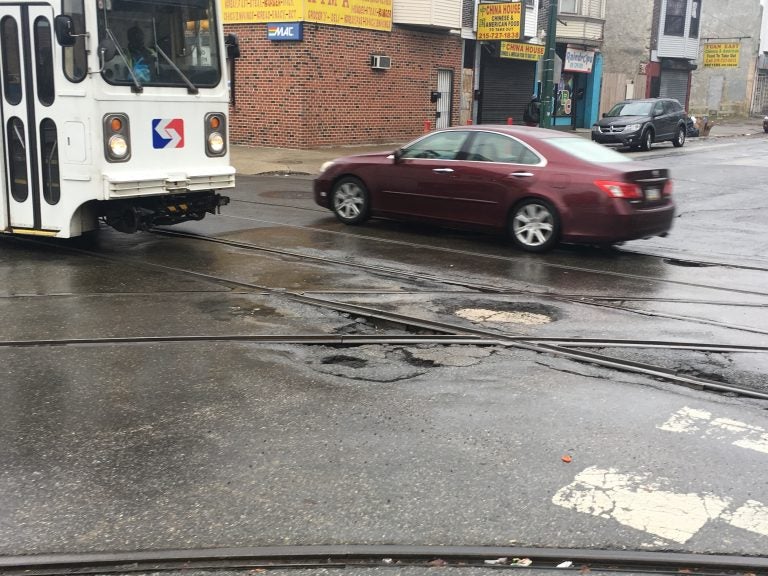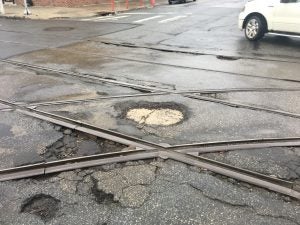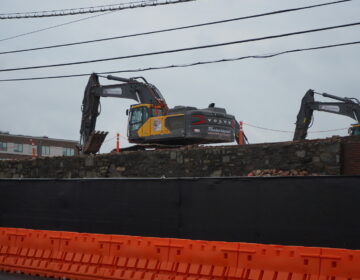Is nanotech the new pothole killer?
Scientists are adding tiny particles of clay, wool and other materials to asphalt — to create more durable pavement.

A trolley in West Philadelphia crosses potholes on a bumpy street. (Malcolm Burnley for WHYY)
Across the country cracks and creases, divvets and ditches are playing havoc with America’s roadways.
A “pothole apocalypse” unfolded in Indianapolis this past winter. Philadelphians are “losing the war against potholes.” And pundits are complaining of potholes the size of Olympic swimming pools in Michigan. That’s all before the ice has fully melted on 2018.
It’s not fully test yet, but scientists have big hopes that nanotechnology will one day help smooth our roads.
Intractable problems
There are many culprits for the frequent potholes on U.S. roadways. Potholes can be the result of normal wear and tear, utility work, or volatile temperature swings that disrupt the chemical properties that keep pavement stuck together.
Asphalt is a critical component in road surfaces — but maybe not what most people think it is.
“Basically, the asphalt really looks like a glue, a glue that holds all the stones together,” says civil engineer Zhanping You, a professor and researcher at Michigan Tech University.
You has studied asphalt for decades, and says laypeople often use the term incorrectly.
Asphalt, which is a derivative of crude oil, helps pavement maintain its shape. Asphalt is often colloquially used to describe the blackish pavement that cars and bikes drive on, but technically it’s one small component of the gravelly mixture we coast on.
“The road really only has 5 percent asphalt in it. … You see the black color, but there are a lot of stones — roughly 95 percent [of the pavement] is rocks, not asphalt,” he says.
Because asphalt tends to liquify in hot temperatures and turn brittle in the cold, the overall pavement, also becomes susceptible to temperature fluctuations.

Both cracking and rutting — when roads develop ridges and valleys as a result of warping — can result in a bumpy, pothole-ridden roadway.
You and his team are studying ways to curtail the temperature volatility of asphalt by adding nano-particles.
“We’d like to see asphalt that’s not really stiff in the wintertime, something that’s still flexible in colder temperatures. And we’d like to see asphalt that is [more] stiff in hotter climates, in summertime, so therefore you can reduce the potential of a rut,” You says.
Their research has found that adding small volumes of a material called “nano-clay” to a traditional asphalt mixture can significantly improve the durability of pavement roads, You says.
The research team found that “we can improve the rutting resistance by half.” And if the technology translates to real life — that means roads could be twice as durable in the heat.
Other researchers around the world are exploring another pothole preventer called “self-healing asphalt.”
By adding small metal fibers, essentially microscopic fragments of steel wool to asphalt mixtures, scientists think there’s potential to create asphalt that re-melts with the application of an external heat source. This new mixture could give pavement the power to plug its own potholes.

In the Netherlands, this new repair method is being tested on public roads. But, it will take years to know if the experimental roads are more durable on a grand scale, compared to traditional asphalt.
In the United States, researchers have found it tough to do real-world testing.
Zhanping You, the civil engineer and researcher at Michigan Tech, estimates that nano-clay-infused asphalt, for example, might cost 20 percent more money to make than traditional asphalt on an industrial scale.
It’s not just a matter of convincing lawmakers that a slightly more expensive asphalt will be a prudent alternative in the long run. There’s also a lack of consensus on the best science. While nano-clay hedges against rutting, and steel wool helps with cracking, there’s not yet a fix that can do both.
Zhanping You is hoping scientists aren’t far away from finding the right asphalt mixture that can do both — and do that inexpensively.
“There is a lot of potential in nano-materials,” You says.
WHYY is your source for fact-based, in-depth journalism and information. As a nonprofit organization, we rely on financial support from readers like you. Please give today.







